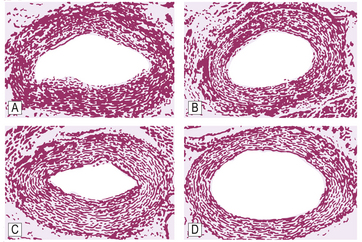Chapter 53 Heart disease
Coronary heart disease (CHD) describes a number of conditions, including angina pectoris and myocardial infarction (MI). Angina pectoris refers to a sensation of tightness or chest pain caused by a brief obstruction or constriction of a coronary artery and MI refers to death of heart muscle (myocardium) as a result of blockage of a coronary artery that prevents oxygen reaching the myocardium.
Causation and prevention
CHD is the commonest cause of premature mortality and a frequent cause of morbidity in western societies. Major well-established risk factors are smoking, hypertension and high serum cholesterol. Additional lifestyle risk factors include physical inactivity (leading to obesity) (see pp. 86–87), hostility and stress.
The type A behaviour pattern (hard-driving, time-urgent and hostile) was identified in the 1960s as typical of the coronary-prone individual. Subsequent research has indicated that high hostility alone is the factor most associated with greater risk of CHD (see pp. 126–127). In surveys, patients and healthy populations believe stress to be the commonest cause of MI (see pp. 62–63). The challenge for health professionals is to educate the population about the importance of behaviours such as smoking in heart disease (see pp. 66–67).
Experimental studies can provide definitive evidence, and strong evidence that stress causes heart disease comes from animal studies. Figure 1 shows cross-sections of coronary arteries of monkeys subjected to different living conditions. Greatest occlusion of the coronary artery was found in dominant monkeys subjected to the stress of having the group they lived with broken up regularly (c). Less occlusion was found in those living in stable groups (a and b) or in subordinate monkeys in unstable social groupings (d).
CHD is related to socioeconomic disadvantage (see pp. 44–45). This may be due in part to patterns of smoking, diet and work experience, as working-class groups smoke more, have a poorer diet and are more likely to have jobs where they have little control and high demands compared with those in the middle classes. CHD is also the major cause of death for both women and men in western countries. However, evidence shows that both women and their doctors may not pay enough attention to this fact. Women fear breast cancer much more that heart disease, although women are about 10 times more likely to die of heart disease than breast cancer over their lifetime (Ulstad, 2001). Similarly, symptoms which doctors attribute to cardiac conditions in men are sometimes attributed to other conditions when presented by female patients. This effect is more common when doctors are working in stressful, time-pressured settings. There has been extensive professional attention recently to address this gender bias in symptom perception.
Stay updated, free articles. Join our Telegram channel

Full access? Get Clinical Tree



